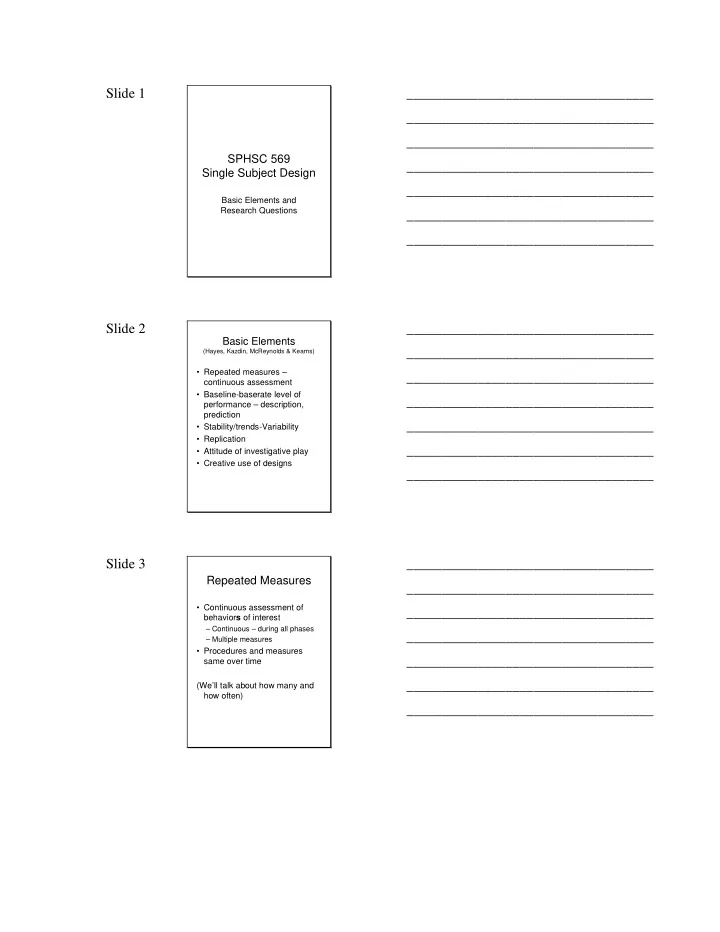

Slide 1 ___________________________________ ___________________________________ ___________________________________ SPHSC 569 ___________________________________ Single Subject Design ___________________________________ Basic Elements and Research Questions ___________________________________ ___________________________________ Slide 2 ___________________________________ Basic Elements ___________________________________ (Hayes, Kazdin, McReynolds & Kearns) • Repeated measures – ___________________________________ continuous assessment • Baseline-baserate level of ___________________________________ performance – description, prediction ___________________________________ • Stability/trends-Variability • Replication ___________________________________ • Attitude of investigative play • Creative use of designs ___________________________________ Slide 3 ___________________________________ Repeated Measures ___________________________________ • Continuous assessment of ___________________________________ behavior s of interest – Continuous – during all phases ___________________________________ – Multiple measures • Procedures and measures ___________________________________ same over time ___________________________________ (We’ll talk about how many and how often) ___________________________________
Slide 4 ___________________________________ Baserate of Performance ___________________________________ • Baseline – A phase ___________________________________ • How many data points? • Types of baselines ___________________________________ – Controlled and uncontrolled • Function of baseline ___________________________________ – Descriptive – Predictive ___________________________________ (handout) ___________________________________ Slide 5 ___________________________________ Stability/Trends– Variability ___________________________________ • Stability – trend – increase, ___________________________________ decrease, or flat/plateau • Variability – no trend Goals: ___________________________________ • Change direction of trend • Make trend more powerful ___________________________________ • Establish a trend Variability – what to do: 1. Wait ___________________________________ 2. Look for factors contributing to variability (client factors, ___________________________________ temporal) 3. Start Tx – establish a trend Slide 6 ___________________________________ Replication ___________________________________ • How many? – Original + 1, 2 (more the better) ___________________________________ – Up to you --- factors to consider • How difficult was it to change the behavior ___________________________________ • Novelty of finding • Past literature • How robust the functional ___________________________________ relation • How unusual the subjects/population ___________________________________ • How unusual the treatment • Number of explanations for finding ___________________________________ Etc.
Slide 7 ___________________________________ Replication ___________________________________ • Types – Direct ___________________________________ • Either within or between subjects – Systematic ___________________________________ • Intraexperimental systematic replication – Variation in experimental ___________________________________ preparation or procedures – slight variation within same experiment ___________________________________ • Interexperimental systematic replication – New experiment to expand or ___________________________________ clarify findings Slide 8 ___________________________________ Replication ___________________________________ • Replication possibilities ___________________________________ – Find no effect – Find opposite effect ___________________________________ – Find partial or mixed effect • What to do ___________________________________ – Check procedural details – any omitted or inaccurately administered ___________________________________ – Consider the “discovery” and explanation ___________________________________ Slide 9 ___________________________________ Attitude of Investigative Play ___________________________________ • Original manipulation ___________________________________ – If it works, why? – If it doesn’t work, why? ___________________________________ • Replication – If it works, why? – If it doesn’t work, why? ___________________________________ Remember -- well designed ___________________________________ study, the data don’t lie! ___________________________________ Have fun!
Slide 10 ___________________________________ Creative Use of Designs ___________________________________ • Elements: ___________________________________ – No treatment – Treatment ___________________________________ – All types of variations in independent variables – Time ___________________________________ • Our approach – discuss designs, but also about how to put different elements together ___________________________________ – Within series – Between series ___________________________________ – Combined series Slide 11 ___________________________________ Research Questions ___________________________________ (Sidman, 1960) • Theory vs. clinically generated ___________________________________ – Do you have a hypothesis or mere curiosity? ___________________________________ • Try out a new method or technique – Independent or dependent ___________________________________ variables • Establish the existence of a ___________________________________ behavioral phenomenon • Explore conditions under which ___________________________________ a phenomenon occurs Slide 12 ___________________________________ Characteristics of Good Research ___________________________________ (Hulley & Cummings) FINER ___________________________________ • Feasible – Sample size ___________________________________ – Technical expertise – Cost ___________________________________ – Scope • Interesting ___________________________________ • Novel • Ethical ___________________________________ • Relevant (consider measures)
Slide 13 ___________________________________ Types/Areas of Research Questions ___________________________________ • Kennedy ___________________________________ – Demonstration – Comparison ___________________________________ – Parametric – Component ___________________________________ • Kendall & Ford-Norton; Olswang – Effectiveness/Efficacy ___________________________________ – Effects – Efficiency ___________________________________ Slide 14 ___________________________________ Types/Areas of Research Questions ___________________________________ Kazdin (1980) ___________________________________ • Treatment package • Dismantling ___________________________________ • Constructing • Parametric ___________________________________ • Comparative • Client & Therapist Variation ___________________________________ • Internal Structure or Process ___________________________________ Slide 15 ___________________________________ Kazdin – Research Questions ___________________________________ • Treatment package ___________________________________ – Determining changes that occur with entire package ___________________________________ • Dismantling – Taking out components of treatment package to see what ___________________________________ is critical • Constructive ___________________________________ – Adding components to see what is important ___________________________________ – Establishes validity of treatment package
Slide 16 ___________________________________ Kazdin – Research Questions ___________________________________ • Parametric ___________________________________ – Varying aspects of treatment to maximize change ___________________________________ – Yeaton and Seachrest • Strength and Integrity ___________________________________ • Comparative – How does one treatment compare to another ___________________________________ ___________________________________ Slide 17 ___________________________________ Kazdin – Research Questions ___________________________________ • Client and Therapist Variation ___________________________________ – Attributes of client and/or therapist serve as variables ___________________________________ worth investigating • Internal Structure or Process – Rosen and Proctor ___________________________________ • Product: – Ultimate change – long term ___________________________________ • Process – Instrumental change – short term ___________________________________ – Intermediate change – short term Slide 18 ___________________________________ Possible Research Questions ___________________________________ ( No shortage of possibilities) • Effectiveness ___________________________________ – Is treatment changing behavior? – Did clinically significant change ___________________________________ occur? – What occurs when manipulation introduced? ___________________________________ – What is the longevity of the change? Durability? ___________________________________ – Did the session provide enough practice to see change? ___________________________________
Recommend
More recommend